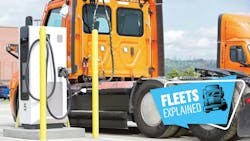Fleets Explained: How are electric vehicles different?
There are about 3.3 million electric vehicles in operation in the U.S. today, according to an Experian Automotive Market Trends report from March 2024. While that sounds like quite a few, with 337 million total vehicles on the road in the U.S. and Canada, EVs make up only 1% of total vehicles on the road.
While EVs aren’t new, with so few people driving them, there are likely things about them that aren’t considered common knowledge. For example, did you know an EV’s range depends on multiple factors and, in some cases, might not meet the retailer’s estimated range? Did you know that one EV can be responsible for more emissions than another EV of the same model, depending solely on location? Keep reading to learn more about electric vehicles.
EV Basics
- EVs use an electric motor powered by a battery pack
- Battery packs are charged by plugging the vehicle into an EV charger
- Chargers are available from Level 1 to Level 3, with Level 3 chargers being the most efficient
- Depending on the energy source, some EVs are responsible for higher emissions than others
- EVs can be more cost-efficient than conventional vehicles over their lifetime
- Charging infrastructure is an obstacle to EV adoption
What are the different kinds of electric vehicles?
Electric vehicles, commonly called EVs (singular, EV) have come a long way since the Nissan Leaf, first introduced in 2010. Perhaps when you think of EVs, a Tesla Model Y comes to mind. Yet, EVs come in all shapes and sizes, designed for personal and commercial use.
There are also different kinds of electrified vehicles, not all of which are fully electric. Consider the plug-in hybrid EV, also known as PHEV, which uses a battery pack to power an electric motor and fuel to power a conventional engine. A PHEV charges via charging station/plugging in and regenerative braking. According to the U.S. Department of Energy, it features an all-electric driving range of 15 to 60 miles.
Fuel cell electric vehicles, known as FCEV, are currently in production primarily by manufacturers of heavy-duty vehicles. Instead of storing electricity in batteries, FCEVs generate electricity through hydrogen vapor that, through a chemical reaction, charges the vehicle battery. Hydrogen fuel cell EVs are more suitable for long-haul operations as the range is typically longer and the smaller battery allows for a higher payload and haul capacity.
Then there are battery electric vehicles, known as BEVs. These vehicles often come to mind when we think of EVs.
Understanding how electric vehicles work
BEVs are all-electric vehicles that do not have an engine or transmission. The vehicle’s electric motor draws power from a large—and quite heavy—battery pack that usually sits beneath the vehicle’s body. The combination of the battery pack, electric motor, and other EV components make up the EV chassis, sometimes referred to as “skateboard.” Batteries charge by plugging in the vehicle to a charger at home, a depot, or a public electric charging station. Because of the weight of the battery pack, BEVs are typically heavier than conventional vehicles, sometimes decreasing payload capacity compared to a similar ICE vehicle.
Additionally, the range of a fully charged BEV is typically less than that of a full tank of fuel powering a conventional engine. Multiple factors can negatively affect the range in an EV. These include extreme temperatures, aggressive driving, and heavier payloads or towing.
EVs must have access to charging to function, much like conventional vehicles need access to fuel. At-home chargers are available through manufacturers of smaller vehicles, electric pickup trucks, and commercial vans. Larger medium-duty and heavy-duty vehicles require more robust charging, which is more favorable to a depot setting.
There are different types of EV chargers, from Level 1 to Level 3, with Level 3 being the most efficient.
-
Level 1:
- Level 1 chargers provide up to 2.4 kW. These chargers plug into a typical household 120V outlet. GreenCars.com suggests using Level 1 charging for PHEVs.
-
Level 2:
- Level 2 chargers provide about up to 12 kW. EV manufacturers might provide these chargers upon the purchase of an EV, but users can also purchase them.
- The U.S. Department of Energy lists nearly 64,000 Level 2 chargers available for public use on its website here.
-
Level 3:
- Level 3 direct current (DC) chargers provide anywhere from 50 to 400 kW.
- These chargers are expensive, with estimated costs from $12,000 to $200,000 for a single charger.
- The U.S. Department of Energy lists nearly 12,000 Level 3 chargers available for public use on its website here.
- Level 3 charging can harm EV batteries, causing them to deteriorate faster than those that regularly use Level 2 chargers, according to an Idaho National Library study.
What’s the difference between an electric vehicle and an internal combustion engine (ICE) vehicle?
There are two main reasons why EVs are gaining momentum in the automotive and commercial spaces: cost savings and environmental concerns.
Because electric vehicles do not emit greenhouse gases into the atmosphere through a tailpipe like a conventional vehicle, BEVs are considered zero-emission vehicles, whereas gas-powered engines emit roughly 20 lb. of carbon dioxide per gallon. With local, state, and federal climate goals and regulations in place, business owners and individuals alike consider EVs as their next vehicle purchase, whether gladly or out of necessity. Although all BEVs are considered zero-emission vehicles, depending on how the local utility generates electricity, one EV could be more environmentally friendly than the next. A utility powering an EV in one town might generate electricity through wind turbines, leading to a cleaner operation than that of an EV in a town where electricity is generated through burning coal.
Then there are the cost-savings of operating BEVs instead of conventional vehicles. BEVs have fewer moving parts than conventional vehicles, which leads to fewer maintenance requirements. Also, the cost of electricity needed to charge an EV is less than fuel. An analysis from telematics provider Geotab found the average lifetime savings of a BEV versus an ICE vehicle in the U.S. is nearly $15,000.
What does charging infrastructure look like for electric vehicles?
An obstacle to EV adoption is the charging infrastructure necessary to operate them. Both federal and private funds are being put forth to build this infrastructure, but building charging infrastructure on even one site can take up to 24 months or even 15 years. This is because utilities often must consider a variety of factors before building charging infrastructure, such as permits, the utility’s energy capacity, the availability of transformers, and more.
About the Author
Jade Brasher
Senior Editor Jade Brasher has covered vocational trucking and fleets since 2018. A graduate of The University of Alabama with a degree in journalism, Jade enjoys telling stories about the people behind the wheel and the intricate processes of the ever-evolving trucking industry.

